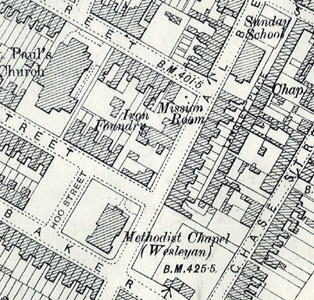Bailey Hill Wesleyan Methodist Church Luton

Bailey Hill Wesleyan Methodist church on a map of 1901
Edwin Welch researched the history of registrations in Bedfordshire for Bedfordshire Historical Records Society Volume 75 Bedfordshire Chapels and Meeting Houses [published in 1996] and found that Bailey Hill Wesleyan Methodist Church in Baker Street was registered on 4th October 1898 by John Joseph Ingram of 43 Stockwood Crescent, superintendent minister; the registration was cancelled on 11th July 1960. The chapel initially formed part of the Chapel Street Circuit.
The chapel replaced the 26 year old chapel a little way away in Albert Road, though that chapel building seems to have continued in use as a Sunday School for Bailey Hill until about 1918. An appeal leaflet sent out after the church was designed but before it was built [MB2274a] reads as follows: “We have pleasure in forwarding you the above view of the New Church which it is intended to substitute for the present School-room in Albert Road”.
![Drawing of the church on the appeal leaflet of 1898 [MB2274a]](/CommunityHistories/Luton/LutonImages/Drawing of the church on the appeal leaflet 1898 [.jpg)
Drawing of the church on the appeal leaflet of 1898 [MB2274a]
“You will be familiar with the long and strenuous efforts made by our workers in that locality to prepare a sanctuary more suited to the needs of public worship, and more worthy of the status of Methodism in this growing town, than the existing premises. We are most thankful that the opportunity has at length arrived for realising this cherished hope…”
“The contemplated structure provides for a present accommodation of about 400 worshippers, whilst the plans are so conceived that room for another 200 may be furnished by extended transepts and an end gallery, when such is required. The Church will be inexpensive, simple in its appointments, and yet substantial and sightly. It will contain no decoration unfitting it for its missionary work in a poor and needy neighbourhood, and yet it will be sufficiently comfortable and elegant to meet the wants and tastes of the better class which is fast filling the multiplying streets in course of formation in the immediate neighbourhood”.
“The entire outlay, inch cost of a valuable site (sufficient for new schools, additional vestries and all other accommodation required), we expect to be about £2,500….”
In 1932 the Wesleyan, Primitive and United Methodists came together to form the Methodist Church of Great Britain. Bailey Hill joined the new Luton Circuit in 1933.
![The church about 1960 [MB2274k]](/CommunityHistories/Luton/LutonImages/The church just before demolition about 1960 [MB22.jpg)
The church about 1960 [MB2274k]
The chapel enjoyed a life of just over sixty years. The last service took place in 1959. In September 1959 a surveyor visited the church and reported that it occupied a site measuring 105 feet by 120 feet. He felt that the chapel and site was worth £3,000 to £3,250 [MB564]. The surveyor commented: “There is a strong feeling this should come down. Without the building there is value in the site”. Eventually the site was put up for sale by auction on 2nd May 1960 [MB564] being described as a “valuable island site bounded by Albert Road, Baker Street, Arthur Street and Hoo Street”.
The site was earmarked by Luton Borough, despite the Methodists hoping for more (between £6,000 and £12,000) than they would give, and a letter of June 1960 [MB564] states: “General approval has been given among folk here to the Corporation having this land for the purpose of Old People’s Flats. It has been publicly announced, people are pleased, and there would be strong feeling if the deal fell through”. The Borough paid £4,000 for the site. The church was duly demolished and flats built on the site.
![Flats built on the site of the church [MB2274k]](/CommunityHistories/Luton/LutonImages/Flats built on the site of the church [MB2274k].jpg)
Flats built on the site of the church [MB2274k]
Bedfordshire and Luton Archives and Records Service has the following records for Bailey Hill:
- MB2274a: appeal leaflet: c. 1898;
- MB2274c: invitation to tender to build the church: 1898;
- MB2274e: conditions of gift of the organ: 1898;
- MB2274d: worship registration certificate: 1898;
- MB2274f: papers concerning the new chapel: 1898-1902;
- MB623: baptism register: 1898-1956;
- MB2274g: Borough Council notice regarding paving in Baker Street: 1899;
- MB2274b: subscription list: c. 1900;
- MB2274h: certificate of registration for marriages: 1902;
- MB2274i: papers regarding paving in Baker Street: 1903;
- MB626: Sunday School minutes: 1909-1925;
- MB627: Society Stewards’ account book: 1913-1921;
- MB628: Sunday School treasurer’s accounts: 1917-1960;
- MB625: Trustees’ minutes including sale of the church: 1932-1961;
- MB2274j: list of trustees: c. 1935;
- MB629: Poor Fund book: 1953-1959;
- MB564: folder on sale of the chapel: 1958-1961;
- MB2274k: photographs of the chapel and of flats later built on the site: c. 1959;
- MB630: correspondence regarding marriage registers and closure of the church: 1960.